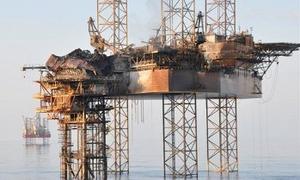Gulf of Mexico oil spillLeaking well may be sealed ahead of schedule
The Deepwater Horizon may be sealed a month or so ahead of schedule — during the second half of July rather than the second half of August — owing to three positive developments: one of two relief wells being drilled will be in a position to engage in “bottom kill” in several days; the containment ship Helix Producer, capable of capturing an additional 53,000 barrels of oil a day, is on station; BP is pressing ahead with plans to swap the current leaky containment cap with a new, no-leak, bolt-down cap

In the background is another platform brought in to drill the relief well // Source: oilonline.com
Nearly three months after the Deepwater Horizon rig started to spew oil in to the Gulf of Mexico, it appears that BP is about finally to seal the leaking well. The drilling of relief wells is ahead of schedule, says BP. Originally slated for completion around mid-August, officials are now saying that one of the two relief wells could intercept the busted well in as little as seven to ten days. Government officials warn, though, that plugging the well with mud and cement, a process known as “bottom kill,” via the relief well could take several days or more to complete.
Sujata Gupta writes in New Scientist that it is not known how the oil is flowing through the original well, but for the bottom kill to work, they will have to hit the right spot in the well casings — and that may take several attempts. In a press briefing on Thursday, Admiral Thad Allen said he is sticking to the original August time frame.
Even if the relief well takes weeks to become fully operational, another temporary plan could stop the flow of oil as early as next week. Firstly an additional containment ship, the Helix Producer, is being lined up to help mop up the oil coming from the wellhead. This will increase BP’s ability to capture oil by an additional 53,000 barrels a day — the overall capacity of 80,000 would be higher than current estimates for the flow rate.
Gupta writes that a break in the weather has encouraged BP to press ahead with plans to swap the current leaky containment cap, which has help collect some oil, with a new cap. Unlike the old cap, which is held in place with a rubber seal that allows oil to seep out, the new cap would be bolted into place.
The process of swapping caps will be daunting, as it will have to be secured by underwater robots. During the procedure, oil will flow unrestrained. The U.S. government, therefore, is putting the pressure on BP to make sure they can have the Helix Producer, an oil-recovery vessel, in place to catch the gushing oil during the swap.
